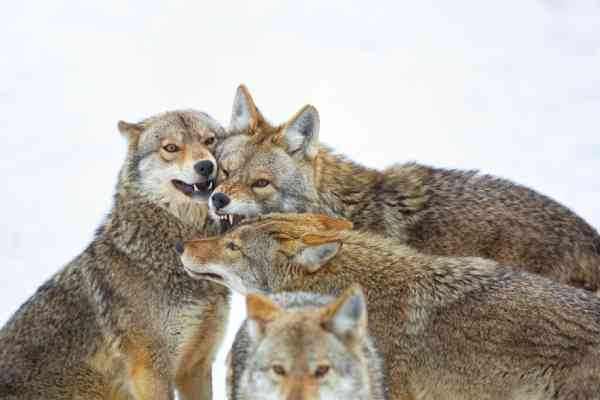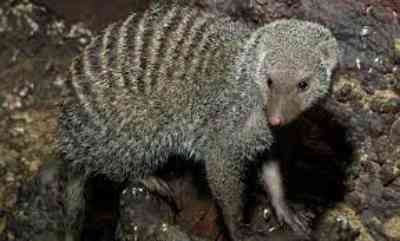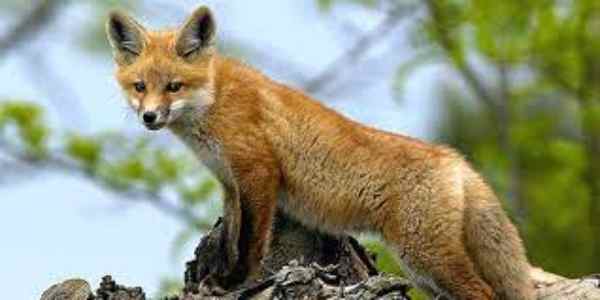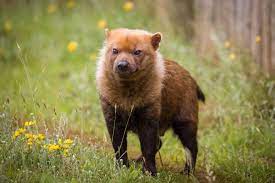Discover the captivating world of monogamous pairing, a fascinating phenomenon not limited to humans alone. Did you ever wonder that some animals also embrace a lifelong commitment to their partners? This extraordinary behavior is more common than you might think and brings about remarkable benefits, especially for their offspring, as they are nurtured and raised by both parents during their crucial early stages of life.
Table of Contents
Beyond our species, a diverse array of creatures, spanning from enchanting birds to intriguing reptiles and other organisms, also engage in lifelong partnerships. This extraordinary behavior serves as a crucial mechanism for passing on their genes to the next generation, ultimately contributing to the growth of their populations. Should an animal fail to find a compatible mate, it may encounter the unfortunate consequences of reproductive failure.
Curious to know more about these amorous marvels? Allow us to take you on a journey through 17 awe-inspiring animals that embrace monogamy with their own unique characteristics. From the enchanting coyotes and adorable dik-diks to the charismatic bush dogs, each species showcased here exudes the sweetness of fidelity in its own special way.
Prepare to be enthralled as we delve into the captivating lives of these monogamous creatures, revealing the intricate details of their devoted relationships and the wondrous world they create together. So, buckle up for an enthralling exploration into the lives of the world’s most devoted animals, as we unravel their enchanting tales of love and commitment.
Bonding Between Animals That Mate For Life
The bond between animals that mate for life is one of the most fascinating things in nature. Unlike some animals that mate with multiple partners, these creatures remain devoted to their mate and will not mate with any others. Mating for life is a sign of a strong, committed relationship and an important factor in the survival of the species.
Interestingly, not all animals are monogamous, but those that are show remarkable loyalty and devotion to their partner. If you’re curious to know which animals prefer to stay together for a lifetime, there are 17 fascinating monogamous species waiting for you to discover.
1. Coyotes – Always In Twos

Coyotes are renowned for their faithfulness, acute senses, and impressive speed. They form lifelong partnerships and stick together, relying on their strong familial bond to raise their offspring with great care.
Alternative Names:
Scientifically labeled as Canis latrans, which translates to “barking dogs,” referring to the sounds they make.
Coyotes are affectionately called by various names such as American jackal, cased wolf, brush wolf, little wolf, and prairie wolf.
Habitat:
Coyotes are adaptable creatures and can survive in a variety of regions, but they primarily inhabit open areas like deserts and prairies. They are commonly found in North America and are considered small relatives of wolves.
Mating and Bonding:
The process of forming lifelong mates begins when a female coyote is ready to find a partner. She starts howling and marking her scent, attracting several suitors over the course of about a month. During this time, she selects one from the group and rejects the others. Once the bond is established, the pair remains monogamous and spends the rest of their lives together.
Breeding Season:
Coyotes typically breed in late February and early March.
Protection of Pups:
When the pups are born, the male coyote takes an active role in caring for them. He diligently guards, grooms, and feeds the young ones alongside the mother coyote.
2. Siamang – Committed Lovers

Scientific Name:
The Siamang is scientifically known as Symphalangus syndactylus.
Habitat:
Siamangs, which are apes, predominantly inhabit hills and lowland forests, including rainforests and monsoon forests in the westernmost regions of Indonesia, certain parts of Thailand, and Malaysia.
Mate Selection:
Siamangs take their time in choosing life partners, and interestingly, if one partner passes away, the surviving partner remains single for the rest of its life.
Mating Behavior:
Unlike many other species, Siamangs do not have a specific breeding season and are not bound to reproduce seasonally.
Parental Responsibilities:
Both male and female Siamangs play crucial roles in the lives of their offspring. The females nurse their young until they reach the age of two years. The male is actively involved in parenting, contributing by defending the territory, protecting the young ones, playing with them, grooming them, and even carrying the juveniles. Remarkably, older siblings also participate in assisting their younger siblings, showcasing a fascinating display of family cooperation and support.
3. Dik-Diks -Together Till Death

Zoological Name:
The dik-dik is a common name for four different species of small antelope associated with the Madoqua genus.
The four dik-dik species are:
- Madoqua piacentini – Silver dik-dik
- Madoqua kirkii – Kirk’s dik-dik
- Madoqua saltiana – Salt’s dik-dik
- Madoqua guntheri – Günther’s dik-dik
Natural Habitat:
Dik-diks thrive in areas abundant with edible food such as shrubs and grasses. They can be found in open regions where giraffes are commonly seen, as well as in thick forests. These antelopes are most frequently found in the savannas and shrublands of eastern Africa.
Monogamous Behavior:
Dik-diks exhibit monogamous behavior, forming lifelong bonds with their partners. Once they find their mate, they remain devoted to each other through various challenges and circumstances.
Breeding Season:
The mating of dik-diks can occur twice in one year, with prominent peaks in June, July, and November.
Benefits of Monogamy for Dik-diks:
Being monogamous, dik-diks are rarely seen apart. This elusive and shy animal relies on well-developed scent, hearing, and sight to protect themselves and their young from danger. Rather than fleeing, dik-diks tend to hide when they sense potential threats.
4. Gray Wolves – Show Loyalty Throughout The Life

Monogamy is not a common trait among most wolf species, but gray wolves stand out for their strong affection and loyalty toward their lifelong mates.
Other Names:
Gray wolves are also known as timber wolves and are scientifically classified as Canis lupus.
Habitat:
Gray wolves predominantly inhabit wilderness areas and remote regions, including shrublands, forests, grasslands, mountain peaks, pastures, wetlands, and deserts. They are found across Eurasia and North America.
Finding a Mate:
Gray wolves identify potential mates by scenting their private parts to determine their readiness for mating. Once they choose each other, they form lifelong partnerships.
Mating Season:
These unique monogamous timber wolves breed from January to April. During this period, only the leading pair of the pack is allowed to mate, maintaining order and hierarchy within the pack. A wolf pack typically consists of parents and their young pups.
Protection of Pups:
Gray wolves take great care of their offspring, providing them with food and shelter in a den to protect them from predators. In the early stages when the pups are too young, the male gray wolf, along with other pack members, brings food to the den, ensuring the female doesn’t need to leave to find food. They also engage in playtime together. As the pups grow, at around eight weeks old, the pack leaves the den and ventures into open areas where they eat, sleep, play, and spend time together.
5. Gibbons -Best Representatives Of True Love

Alternative Names:
Gibbons belong to the Hylobatidae family. They are a type of ape and are sometimes referred to as lesser apes, distinguishing them from great apes like gorillas and chimpanzees. Gibbons are also classified as primates.
Habitat:
Hylobatidae predominantly inhabit the trees of rainforests in southern Asia.
Mating Behavior:
There is relatively limited information and research on gibbon mating behavior. However, it is observed that males initiate mating more frequently than females. Gibbon females use non-behavioral cues to signal their readiness to mate with the males. Gibbons are known for practicing serial monogamy.
Breeding Season:
Gibbons are not bound to a specific breeding season and can breed throughout the year.
Role of Gibbons in Raising Their Offspring:
Female gibbons take care of their young for a minimum of two years. Older siblings also play a role in looking after and caring for their younger siblings. The male gibbon actively participates in assisting and grooming the young gibbons as well.
6. Gray Foxes – Endlessly Together

Other Names:
Gray foxes are also known as Tree Fox, Common Gray Fox, and Maned Fox. Their binomial name is Urocyon cinereoargenteus.
Habitat:
Gray foxes prefer to live near river banks, especially in areas with softwood, dense hardwood, and mixed hardwood forests.
Finding a Mate:
Gray foxes are elusive creatures and, once mature, begin seeking mates during the fall season.
Breeding Season:
The breeding season for gray foxes spans from January to March.
Parental Care:
When the kits (young foxes) are born, the gray fox couple engages in social behavior with each other and their offspring. They utilize dens as a safe space for raising their kits.
7. Titi Monkeys – Loyal Mates

Other Names:
Titi monkeys are scientifically known as Callicebus.
Habitat:
Titi monkeys can be found in swamps and forests along lake shores and rivers, primarily dwelling in the lower tree canopy of the Amazon River basin.
Mating Behavior:
Titi monkeys are known for their close social bonds. They spend their days and nights together, engaging in grooming activities, which helps them maintain strong relationships with each other.
Breeding Season:
Breeding among titi monkeys takes place between November and March.
Parental Role:
Similar to other monogamous animals, titi monkeys exhibit biparental care for their young offspring. Both parents actively participate in the care and upbringing of their babies.
8. Prairie Voles – Lifetime Affection

Other Names:
Prairie Voles are scientifically known as Microtus ochrogaster.
Habitat:
Prairie Voles prefer to inhabit dry fields covered with weeds and grasses.
Bonding:
Prairie Voles form long-lasting bonds. The male engages in courtship behavior, and when the female accepts him, they mate.
Breeding Season:
Breeding among Microtus ochrogaster occurs throughout the year, but they avoid breeding during severe conditions, such as extreme summer and winter.
Parental Role:
Microtus ochrogaster exhibits strong parental instincts. They stay with their infants to protect them and actively participate in retrieving them and promoting their development.
9. Golden Jackal- Protective Partners

Other Names:
Golden jackals are also known as Asiatic jackals, common jackals, and Eurasian golden jackals.
Habitat:
Asiatic jackals are well-adapted to various environments, including deserts, savannas, arid grasslands, mountains, marshes, and bushlands.
Mating Behavior:
Golden jackals form strong bonds when they mate for life. They use different howls to locate each other and engage in groaning together to showcase the strength of their bond.
Breeding Season:
The breeding season of golden jackals varies depending on the region. In India, breeding occurs year-round, while in East Africa, it typically takes place in October.
Monogamous Role of Golden Jackals:
During the female jackal’s birthing period in their den, both partners play a protective role in guarding the young ones. The monogamous relationship fosters grooming of the juveniles, increased time spent on their protection, and provision of food for their offspring.
10. Fat-Tailed Dwarf Lemur – Socially Monogamous

Other Names:
Fat-tailed dwarf lemurs are also known as lesser dwarf lemurs and western fat-tailed dwarf lemurs. Their binomial name is Cheirogaleus medius.
Habitat:
Fat-tailed dwarf lemurs are commonly found in thorn scrub, moist evergreen forests, and dry deciduous forests.
Mating Behavior:
These lemurs are known for their monogamous nature and loyalty to their partners. However, if one partner dies, the surviving individual may find a new mate.
Breeding Season:
The breeding season for fat-tailed dwarf lemurs begins when they come out of hibernation at the end of November.
Protection of Offspring:
Fat-tailed dwarf lemurs form small family units, consisting of a pair of western fat-tailed dwarf lemurs and one or two offspring. They stay together to protect their infants from predators. In some cases, if they encounter reproductive failure, they may engage in cheating behavior on their partners.
11. Marmosets – Together For Long Term
Other Names:
Marmosets are also commonly called sagoin or Paris. Their scientific name is Callithrix jacchus.
Habitat:
Marmosets inhabit various forest types, including riverine forests in dry thorn scrub habitats, extreme northern Atlantic coastal forests, semi-deciduous inland forests, and others.
Socially Monogamous:
Similar to many other animals, marmosets find a mate for themselves, and once they form a bond, they mate for life, displaying social monogamy. They exhibit affection and care for each other.
Breeding Season:
Marmosets are continuously breeding animals, but the peak of their breeding season occurs from September to November and from April to June.
Protection of Young Marmosets:
Male marmosets are known for being dedicated fathers among various animal species. They actively care for their young, taking on tasks such as grooming and carrying them on their backs. The male marmoset takes care of the infants, allowing the female to recover from labor and going above and beyond to protect and raise the offspring. Male marmosets remain with the family and sometimes even care for the babies of other partners, demonstrating care and support for the entire social group. This behavior showcases why they are among the list of top animals that mate for life.
12. Narrow-Striped Mongoose – May Be Loyal

Other Names:
The narrow-striped mongoose is scientifically known as Mungotictis decemlineata and is commonly referred to as narrow-striped vontsira.
Habitat:
Narrow-striped mongooses inhabit the Madagascar dry deciduous forests in southwestern and western Madagascar.
Monogamous Relationship:
These mongoose species are considered monogamous as they form pairs and stay together for the majority of their lives.
Breeding Season:
The breeding season for narrow-striped mongooses is not restricted to specific months, as they breed annually. However, the peak breeding activity may occur from December to April.
Rearing the Young:
Narrow-striped mongooses have unique rearing systems where they live in matriarchal family groups. This means that the females play a prominent role in raising and caring for the young.
13. Red Foxes – Stuck Together

Other Names:
The red fox is commonly known as the common fox and is scientifically identified as Vulpes vulpes.
Habitat:
Red foxes prefer to create their homes near tilled fields, forest edges, and marshes.
Finding a Mate:
During the spring season, red foxes use various communicative cues to find a mate. They also engage in scent marking as a form of communication for this purpose.
Breeding Season:
The mating season for red foxes typically spans from January to March.
Protection of Pups:
Both partners play a role in caring for the pups. If there are older siblings, they also contribute to protecting and providing food for the younger ones. This cooperative behavior ensures the well-being and safety of the entire fox family.
14. Japanese Serow – Maybe Faithful, Maybe Not.

Other Names:
The Japanese serow is scientifically known as Capricornis crispus. It is commonly referred to as kamoshika or karashishi in Japan. In history, it has been given various specific names such as cow domain, mountain sheep, wool deer, and nine tail cow due to its appearance.
Habitat:
The Japanese serow, a monogamous animal, prefers temperate deciduous forests and inhabits open woodlands and grasslands.
Mating Behavior:
When Japanese serows form pairs, the male takes on the role of protecting and defending the female. They mate during their breeding season.
Breeding Period:
The Japanese serows breed once a year, typically between September to November, and form lifelong bonds with their chosen partners.
Raising the Young:
Japanese serows actively raise and guard their young offspring until they reach adulthood, displaying a strong sense of parental care and protection.
15. Tibetan fox – Forevermore

Other Names:
Tibetan foxes are also known as Wamo, we, Tibetans, or sand foxes. In scientific terms, they are referred to as Vulpes ferrilata.
Habitat:
Tibetan foxes can be found in the treeless slopes of Nepal and the high-altitude grassland plains of the Tibetan Plateau, India, and China.
Monogamous Relationship:
Tibetan foxes form lifelong mate-for-life relationships, staying together, resting, hunting, and traveling as a pair.
Breeding Season:
The square-like-faced Tibetan fox is a monogamous animal that mates during February and March to increase its population.
Protection of Pups:
The young Tibetan foxes, known as kits, cubs, or pups, are cared for by the pair. The foxes dig holes to provide protection and security for their offspring. The young sand foxes stay with their parents for about 8 to 10 months before becoming independent.
16. Bush Dog – Breed Year round

Other Names:
Bush dogs are also commonly known as vinegar dogs or savannah dogs. Their scientific name is Speothos venaticus.
Habitat:
Bush dogs prefer to live near water bodies and typically inhabit wet savannas and forests in various regions.
Mating Behavior:
Bush dogs are monogamous and form strong, unbreakable bonds with their partners. They often occur in extended family groups.
Breeding Season:
Although bush dogs breed only once a year, it is remarkable that they have the ability to breed in all 12 months.
Parental Role of Bush Dogs:
When the bush dog infants are born, the parents stay with them in underground dens for a few weeks. The parents actively protect, clean, and assist in moving the young savannah dogs during this early stage of their lives.
17. Greater Galago – Apparently, Together

Other Names:
The greater galago is also known by various other names such as greater bushbaby, thick-tailed bushbaby, large-eared greater galago, Garnett’s greater galago, and thick-tailed greater galago.
Natural Habitat:
The greater galago is found in equatorial and subtropical regions, primarily dwelling in coastal forests and riverine areas. They may also occasionally appear in woodland savannahs.
Monogamous Relationship:
While the greater galago is generally considered monogamous, it can sometimes become polygamous depending on their population dynamics. However, in most cases, they form monogamous relationships, living together and caring for their offspring.
Breeding Season:
The mating season of the greater Galagos varies depending on their location, but it usually occurs once, from June to November.
Protection of Offspring:
The male greater galago unintentionally helps protect and defend its babies, while the female takes on the responsibility of feeding them and providing care. This cooperative approach ensures the well-being and protection of the young Galagos.
FAQs
What animal has a lifelong mate?
Beavers
Do any animals mate for life?
Some of the most well-known monogamous creatures include wolves, swans, and albatrosses, who choose one partner and remain loyal to them for years, or even their entire lives. While researchers are still learning more about the biology and behavior behind lifelong mating habits, one thing is clear: these animals prove that true love can exist in the animal kingdom.
Which animal mates the most?
Brown antechinus
Final Words
The animal kingdom is filled with fascinating creatures that display extraordinary behavior, and among them are the ones that mate for life. These animals form strong bonds that last throughout their entire lives. From wolves to swans, these monogamous animals work together to protect and defend their offspring from any danger that may come their way.
They show a level of affection and care for each other that is unmatched in the animal kingdom. They take turns finding food, cleaning their young ones, and playing with them. Although a rare concept in today’s world, these animals exemplify the beauty of long-lasting relationships built on love and loyalty.
Reference:
- https://www.britannica.com/list/6-animal-species-that-mate-for-life
- https://nicenews.com/animals/animals-mate-for-life/
- https://www.peta.org/features/relationships-animals-mate-for-life/

Rahul M Suresh
Visiting the Zoo can be an exciting and educational experience for all involved. As a guide, I have the privilege of helping students and visitors alike to appreciate these animals in their natural habitat as well as introducing them to the various aspects of zoo life. I provide detailed information about the individual animals and their habitats, giving visitors an opportunity to understand each one more fully and appreciate them in a more intimate way.









